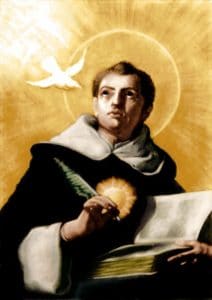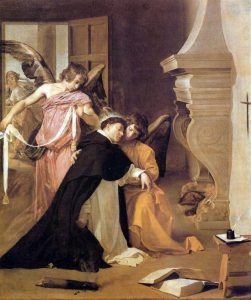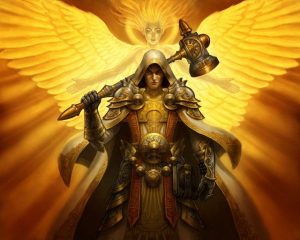Clerics have been a part of roleplaying games from the very beginning. When Gary Gygax created the first edition of Dungeons and Dragons, it only contained three types of characters: the Magic-User, the Fighting Man, and…a Cleric.
Clerics continued to play a foundational role in roleplaying games for the 40 years that followed, even if they’ve been tweaked, mashed-up, or have gone by different names, such as priest or healer. Skid Maher plays the cleric Gelabrous Finn in the Glass Cannon Podcast and speaks to the crucial importance of clerics in roleplaying games. Maher deadpans that “in worlds where gods demonstrably exist” the clerics who are agents of those gods become a pretty big deal.
But let’s set aside Golarion, the Forgotten Realms, and all the other roleplaying worlds where clerics are so common they begin to be taken for granted. What about the world we live in? Who are the real world clerics that Gary Gygax used for inspiration when he first sketched them out next to a Magic-User and Fighting Man?

Thomas Aquinas was born in a castle in Italy during medieval times (1225 AD). His father, Landulf of Aquino, was a Knight in the service to King Roger II. Aquinas’ uncle Sinibald was abbot of the first Benedictine monastery at Monte Cassino. While Landulf’s other sons pursued military careers (nee: Fighting-Men), the family intended for Thomas to follow his uncle into a more holy path, albeit one of great privilege.
A military conflict spilled into the abbey, which prompted Aquinas’ parents to enroll 5-year-old Thomas in school in Naples. Despite going on to become one of the most influential theologians in the history of the church, his classmates bullied him, calling him the “dumb ox” because he was a lumbering man who was reserved and shy.
At 22 Aquinas leveled up and published his first works on philosophy. He leveled again at 32 when he received his doctorate, and he’d go on to publish 60 volumes on theology, philosophy, and more, proving he had a 20 for an intelligence score. Fittingly, he is the Catholic patron saint of students, schools, and universities.
When it came time for Thomas Aquinas to begin his adventuring career, his parents envisioned something more prestigious for Thomas. Instead, he chose to join a Dominican Order of Monks, a lifestyle that his parents saw as a significant step down in the world, since the Dominicans preached devotion and a simple lifestyle, choosing to forego earthly extravagance and pleasures. His alignment was clearly lawful good.

When his family found out he had joined the Dominicans, a band of soldiers led by his brother Rinaldo captured Thomas and brought him back home, imprisoning him for a year in the castle.
During this time his family tried to persuade him to give up his dream of a life of humble service. But Aquinas was stubborn.
Two of his brothers resorted to hiring a prostitute to seduce Thomas, but Thomas drove her away, saying that two angels appeared to him as he slept and strengthened his determination to remain faithful.
Thomas’ mother Theodora, seeing that all of the family’s attempts to dissuade Thomas had failed, arranged for Thomas to escape at night through a window. By this point the life of Thomas Aquinas has shown that history can sometimes be just as fantastical as the stories us nerds imagine in our games.
But Thomas Aquinas wan’t done leveling up. He went on to have one of the most distinguished careers that the Catholic church has ever seen, eventually achieving sainthood. Legends say that miracles surrounded him as well, so he had a pretty nifty list of spells. His simplest trick was that beautiful fragrance was said to have followed him, and for centuries there were recurring claims that Aquinas had the ability to levitate.
Then of course, as any good cleric is want to do, there were numerous tales of Thomas Aquinas healing the sick and curing the wounds of the downtrodden and outcast.

If he was a character, the Tempest Domain that is available for 5th edition D&D clerics would be a bad fit for Aquinas. He had a lifelong fear of storms, stemming from his infant sister being killed by lightning when they were both taking a nap in the same room of the castle. But the Light Domain fit Aquinas to a tee, as he was regularly called ‘the light of the church.’
Had Thomas Aquinas played D&D, he never would have played a chaotic evil character. And I’d bet $1,000 that if Aquinas had been a DM, his campaigns would have been about the triumph of good over evil.
For Thomas Aquinas, courage and justice were non-negotiable virtues, while cowardice and injustice were vices. He was resolute in his belief that moral character mattered and he lived out those ideals without compromise. And why wouldn’t he? Aquinas had God on his side.
Whereas the Dark Necromancer himself, the philosopher Friedrich Nietzsche, pooh-poohed Aquinas’ traditional notions of truth and morality, the good cleric had more than his fair share of fantasy fans. G.K. Chesterton, C.S. Lewis, and J.R.R. Tolkien himself were all thoughtful adherents of the good cleric Thomas Aquinas, and their highly influential fantasy writings reflected that adherence.
While the notion that fantasy has morality in its DNA might leave some players squirming, clerics like Thomas Aquinas are clearly within the canon of fantasy literature. And Thomas Aquinas was a credible real-life, living-and-breathing hero who exhibited the personal virtues he espoused.
Justice, generosity, compassion, loyalty, self-control, mercy, temperance, wisdom and the panoply of human experience were woven into the life of Thomas Aquinas. He wrestled with the questions such as How is it best to live? What kind of life is worthy of emulation? How can be best love our fellow humans?, then came out the other side of those questions as a shining light for others to look to.
It is a darned unfortunate irony that the parents and religious leaders of yesteryear who were so concerned over the influence of Dungeons and Dragons failed to see that clerics like Thomas Aquinas actually furnished them with a wonderful means to explore morality.
A cleric modeled after Thomas Aquinas can serve as an example that if we sit around a table to play in a world like Dungeons and Dragons, we are likely to return from it better than when we started.

